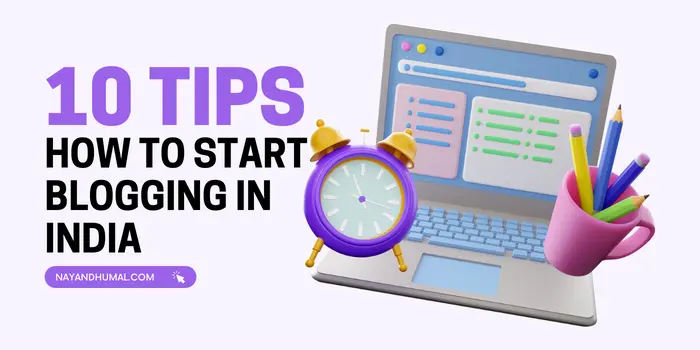Blogging in India has witnessed significant growth and evolution in recent years, establishing itself as a prominent platform for individuals to express ideas, share information, and engage with diverse audiences. The blogging landscape in India encompasses a wide range of topics, including but not limited to technology, lifestyle, travel, finance, health, and education. With the increasing internet penetration and the rise of social media, blogs have become powerful mediums for individuals to voice their opinions, showcase their expertise, and connect with like-minded communities.
Importance of Blogging for Personal and Professional Growth
Personal Expression: Blogging provides a unique avenue for personal expression, allowing individuals to share their thoughts, experiences, and creative endeavors with a global audience. It serves as a digital diary where personal stories, reflections, and insights can be chronicled.
Skill Development: Managing a blog involves various skills such as writing, content creation, digital marketing, and social media management. Engaging in these activities contributes to personal skill development and a deeper understanding of online communication.
Building a Personal Brand: Blogging enables individuals to build a personal brand and establish themselves as experts in their respective fields. Consistent and valuable content can enhance credibility and visibility, opening up opportunities for collaborations and partnerships.
Networking and Community Building: Through blogging, individuals can connect with a community of like-minded individuals, fostering meaningful relationships and discussions. This networking aspect can lead to collaborations, friendships, and opportunities for personal and professional growth.
Key Benefits of Starting a Blog in India
Diverse Audience: India’s diverse population provides bloggers with the opportunity to address a wide range of interests and preferences. This diversity allows for niche blogging and catering to specific target audiences.
Monetization Opportunities: Successful blogs can be monetized through various channels such as sponsored content, affiliate marketing, and advertising. This potential for financial gain makes blogging a viable avenue for those looking to turn their passion into a source of income.
Educational and Informational Impact: Blogs in India serve as valuable sources of information, education, and awareness on a plethora of topics. They contribute to the dissemination of knowledge and can play a crucial role in shaping public opinions and perspectives.
Online Influence: As influencers gain prominence in the digital landscape, blogging provides a platform for individuals to become influential voices in their respective domains. A strong online presence can lead to opportunities for brand collaborations and sponsorships.
Blogging in India has become a dynamic and influential medium, offering individuals a platform for personal expression, skill development, and opportunities for personal and professional growth. The diverse and evolving blogging landscape in the country presents a wealth of possibilities for those willing to embark on this digital journey.
Choosing Your Niche
A. Identifying Your Passion and Expertise
Self-Reflection: Start by identifying your interests, hobbies, and areas of expertise. A successful blog often stems from genuine passion and a deep understanding of the chosen niche.
Skills and Knowledge: Consider your skills and knowledge in specific areas. Assess what you can offer that sets you apart, whether it’s a unique perspective, specialized knowledge, or a particular skill set.
Long-Term Commitment: Choose a niche that you can see yourself being passionate about for the long term. Consistency is key in blogging, and sustained interest in your chosen niche will contribute to the longevity and success of your blog.
B. Researching Popular Blog Niches in India
Trending Topics: Explore current trends and popular topics in India. This could include lifestyle, health and wellness, technology, finance, travel, food, fashion, or a combination of these. Look for niches that align with your interests and have a substantial audience.
Audience Engagement: Assess the level of engagement in different niches by researching existing blogs and social media platforms. Look for communities that actively discuss and share content related to your potential niche.
Keyword Research: Use tools like Google Trends and keyword research tools to identify search trends and popular topics. This can give you insights into what people are actively searching for, helping you choose a niche with a potential audience.
C. Evaluating the Potential for Monetization in Your Chosen Niche
Affiliate Marketing: Research if your chosen niche has products or services that can be promoted through affiliate marketing. Many bloggers generate income by earning a commission for each sale or lead generated through their affiliate links.
Sponsorship Opportunities: Evaluate if there are opportunities for sponsorships and collaborations within your niche. Brands often look for influencers and bloggers to promote their products or services to a targeted audience.
Product Creation: Consider whether your niche allows for the creation of your own products or services. This could include e-books, online courses, merchandise, or consulting services.
Advertising Potential: Assess the potential for advertising revenue through platforms like Google AdSense. Certain niches may attract higher-paying ads, contributing to your blog’s monetization strategy.
Subscription Models: Explore whether your niche lends itself to a subscription-based model, where users pay for premium content or exclusive access. This can be particularly effective in niches with a dedicated and engaged audience.
Choosing the right niche involves a balance between personal passion, market demand, and potential for monetization. By aligning your interests with popular and monetizable niches in India, you can set the foundation for a successful and sustainable blogging journey.
Setting Up Your Blog
A. Choosing a Domain Name and Hosting Provider
Domain Name Selection:
- Pick a domain name that reflects your blog’s content and is easy to remember.
- Keep it concise, avoiding complex spellings or hyphens.
- Ensure the domain is available and not already in use.
Selecting a Hosting Provider:
- Research reputable hosting providers that offer reliable services.
- Consider factors like server performance, customer support, and pricing.
- Popular hosting options include Bluehost, SiteGround, and HostGator.
Registering Your Domain:
- Register your chosen domain through the hosting provider or a dedicated domain registrar.
- Choose a hosting plan that suits your needs, considering factors such as storage, bandwidth, and scalability.
B. Selecting a Blogging Platform (WordPress, Blogger, etc.)
WordPress:
- WordPress is widely used and versatile, offering a range of themes and plugins.
- Ideal for both beginners and experienced bloggers.
- Allows for easy customization and scalability.
Blogger:
- Owned by Google, Blogger is user-friendly and integrates seamlessly with other Google services.
- Simple interface, making it suitable for beginners.
- Limited in terms of advanced features compared to self-hosted platforms.
Medium:
- Medium is a platform that focuses on content creation and community engagement.
- Minimal setup is required, making it suitable for those prioritizing content over customization.
- Monetization options are available for eligible writers.
Other Platforms:
- Explore alternative platforms based on your specific needs, such as Wix, Squarespace, or Ghost.
- Consider factors like ease of use, customization options, and the ability to scale as your blog grows.
Customizing Your Blog’s Design and Layout
Selecting a Theme:
- Choose a visually appealing and responsive theme that aligns with your blog’s content.
- Ensure the theme is mobile-friendly for a better user experience.
Customizing Colors and Fonts:
- Personalize your blog by selecting colors and fonts that match your brand or personal style.
- Maintain readability by choosing clear and legible font styles.
Adding Essential Pages:
- Create essential pages such as an “About Me” page, a “Contact” page, and a “Privacy Policy” page.
- Clearly articulate your blog’s purpose and provide a way for readers to connect with you.
Integrating Plugins (For WordPress):
- Use plugins to add functionality to your WordPress blog, such as SEO optimization, social media sharing, and contact forms.
- Install only essential plugins to avoid impacting your site’s performance.
Optimizing for SEO:
- Optimize your blog for search engines by using relevant keywords in your content.
- Install an SEO plugin to assist with on-page optimization.
By carefully selecting a domain name, hosting provider, and blogging platform, and by customizing your blog’s design and layout, you’ll establish a solid foundation for a successful and visually appealing online presence.
Creating Compelling Content
A. Understanding Your Target Audience
Demographic Analysis:
- Identify the age, gender, location, and interests of your target audience.
- Understand their preferences, needs, and challenges to tailor your content accordingly.
Engagement Metrics:
- Use analytics tools to track user engagement on your blog.
- Analyze popular content, comments, and social media interactions to gauge audience interests.
Feedback and Surveys:
- Encourage feedback through comments and surveys to gather insights.
- Address audience preferences and concerns to refine your content strategy.
B. Developing a Content Strategy
Define Your Purpose:
- Clearly articulate the purpose and goals of your blog.
- Determine whether you aim to inform, entertain, inspire, or educate your audience.
Content Calendar:
- Develop a content calendar outlining the frequency and schedule of your posts.
- Plan for seasonal or trending topics to stay relevant.
Content Mix:
- Diversify your content with a mix of articles, visuals, videos, and other media.
- Cater to different learning preferences and keep your content engaging.
Consistency:
- Maintain consistency in your writing style, tone, and posting schedule.
- Build trust with your audience by delivering content reliably.
Evergreen and Trending Topics:
- Balance your content with evergreen topics that remain relevant over time.
- Stay informed about trending topics in your niche and incorporate them into your strategy.
C. Tips for Writing Engaging and SEO-Friendly Blog Posts
Compelling Headlines:
- Craft attention-grabbing headlines that pique curiosity.
- Include relevant keywords to improve search engine visibility.
Quality Content:
- Focus on providing valuable, well-researched, and original content.
- Solve problems, answer questions, or entertain your audience to keep them engaged.
Readability:
- Use short paragraphs, subheadings, and bullet points to improve readability.
- Break down complex ideas into digestible sections.
Visual Elements:
- Incorporate high-quality images, infographics, and videos to enhance your content.
- Visuals can break up text and make your posts more appealing.
SEO Optimization:
- Conduct keyword research to identify relevant terms for your niche.
- Naturally incorporate keywords in your content, titles, and meta descriptions.
Internal and External Links:
- Include internal links to previous relevant posts on your blog.
- Link to reputable external sources to add credibility to your content.
Engage with Your Audience:
- Encourage comments, and respond to them promptly.
- Foster a sense of community by interacting with your audience on social media.
Mobile-Friendly Content:
- Ensure your content is optimized for mobile devices to reach a broader audience.
- Check the mobile responsiveness of your blog’s design and layout.
By understanding your audience, developing a thoughtful content strategy, and implementing writing techniques that cater to engagement and SEO, you can create compelling blog posts that resonate with your readers and enhance the overall success of your blog.
Building Your Brand
A. Crafting a Unique and Memorable Brand Identity
Define Your Brand Personality:
- Clearly outline the personality and values you want your brand to portray.
- Consider whether your brand is more casual, formal, authoritative, or friendly.
Identify Your Unique Selling Proposition (USP):
- Determine what sets your blog apart from others in your niche.
- Highlight your strengths and what makes your content and perspective distinctive.
Target Audience Alignment:
- Ensure your brand identity resonates with your target audience.
- Craft your messaging and visuals to appeal to the interests and preferences of your audience.
B. Creating a Professional Logo and Blog Visuals
Design a Memorable Logo:
- Create a unique and visually appealing logo that reflects your brand identity.
- Consider hiring a professional designer or using design tools for a polished result.
Consistent Visual Elements:
- Establish a consistent color scheme, typography, and imagery across your blog and promotional materials.
- Consistency reinforces brand recognition and professionalism.
High-Quality Images:
- Use high-quality images that align with your brand’s style and aesthetic.
- Invest in professional photography or utilize reputable stock photo sources.
Branded Graphics and Templates:
- Design branded graphics and templates for blog post featured images and social media posts.
- Consistent visuals create a cohesive and recognizable brand presence.
Consistent Branding Across Social Media Platforms
Unified Profile Imagery:
- Use the same profile picture and logo across all social media platforms.
- Consistency fosters instant recognition for your audience.
Bio and Descriptions:
- Craft concise and consistent bios and descriptions that reflect your brand’s voice.
- Include key information about your blog, its purpose, and what sets it apart.
Posting Style and Frequency:
- Maintain a consistent posting style, whether it’s the tone of your captions or the types of content you share.
- Develop a posting schedule that aligns with your brand’s identity.
Engagement and Interaction:
- Engage with your audience consistently by responding to comments, messages, and mentions.
- Showcase the human side of your brand by actively participating in discussions and conversations.
Branded Hashtags:
- Create and promote branded hashtags to encourage user-generated content and community engagement.
- Use these hashtags consistently across your social media platforms.
Collaborations and Partnerships:
- Collaborate with influencers or brands that align with your identity.
- Ensure that partnerships reflect positively on your brand and contribute to its growth.
Building a strong brand involves creating a distinct identity, using professional visuals, and maintaining consistency across various platforms. By focusing on these elements, you can establish a memorable and trustworthy brand that resonates with your audience and contributes to the long-term success of your blog.
Promoting Your Blog
A. Utilizing Social Media for Promotion
Choose Appropriate Platforms:
- Identify the social media platforms that align with your target audience and niche.
- Utilize platforms such as Instagram, Twitter, Facebook, Pinterest, or LinkedIn based on your content type.
Consistent Posting:
- Develop a consistent posting schedule to keep your audience engaged.
- Experiment with posting times to identify when your audience is most active.
Visual Content:
- Share visually appealing content, including images, infographics, and videos.
- Leverage features like Instagram Stories and Reels for dynamic engagement.
Engage with Your Audience:
- Respond promptly to comments, messages, and mentions.
- Initiate conversations, ask questions, and encourage user-generated content.
Hashtags and Trends:
- Use relevant hashtags to increase the discoverability of your content.
- Stay updated on trending topics and incorporate them into your social media strategy.
B. Engaging with the Blogging Community in India
Participate in Forums and Groups:
- Join blogging communities, forums, and groups related to your niche.
- Share your expertise, ask questions, and engage in discussions to build relationships.
Collaborate with Other Bloggers:
- Seek collaboration opportunities with fellow bloggers in India.
- Collaborative projects, guest posts, and joint events can expand your reach.
Attend Blogging Events and Meetups:
- Attend blogging conferences, webinars, and meetups to network with other bloggers.
- Share your experiences and learn from the successes and challenges of your peers.
Feature Other Bloggers:
- Highlight and feature other bloggers in your niche.
- This fosters a sense of community and may lead to reciprocal support.
C. Exploring Email Marketing and Other Promotional Strategies
Build an Email Subscriber List:
- Encourage blog visitors to subscribe to your email list.
- Provide valuable content, exclusive updates, and incentives to attract subscribers.
Create Engaging Newsletters:
- Craft newsletters that provide value to your subscribers.
- Share blog updates, exclusive content, and promotions to keep your audience informed.
Collaborate with Influencers:
- Identify influencers or thought leaders in your niche and explore collaboration opportunities.
- Influencer partnerships can introduce your blog to new audiences.
Run Contests and Giveaways:
- Organize contests or giveaways to encourage user participation and engagement.
- Leverage social media platforms and email newsletters to promote these activities.
Paid Advertising:
- Consider paid advertising on platforms like Facebook or Instagram.
- Target specific demographics to reach audiences interested in your niche.
SEO Optimization:
- Continuously optimize your blog for search engines.
- Implement SEO best practices to improve organic visibility and attract new readers.
By strategically utilizing social media, engaging with the blogging community, exploring email marketing, and implementing other promotional strategies, you can effectively increase the visibility of your blog in India. A comprehensive approach to promotion will contribute to growing your audience and establishing a strong online presence.
Monetization Options
A. Google AdSense and Other Ad Networks
Google AdSense:
- Google AdSense is a popular advertising network that allows bloggers to earn revenue through display ads on their websites.
- Apply for an AdSense account, and once approved, place ad units on your blog.
- Earnings are generated based on ad impressions and clicks.
Other Ad Networks:
- Explore alternative ad networks such as Media.net, Ezoic, or AdThrive, depending on your blog’s traffic and niche.
- Consider ad networks that offer higher payouts or specialized ad formats.
Direct Ad Sales:
- Sell ad space directly to businesses or advertisers.
- Set your rates and negotiate terms directly, providing more control over the types of ads displayed on your blog.
B. Affiliate Marketing Opportunities
Join Affiliate Programs:
- Sign up for affiliate programs related to your blog’s niche.
- Promote products or services, and earn a commission for each sale or lead generated through your unique affiliate links.
Promote Relevant Products:
- Choose products or services that align with your content and audience.
- Provide honest and valuable reviews to build trust with your readers.
Strategic Placement:
- Integrate affiliate links naturally within your content.
- Consider using banners, call-to-action buttons, or dedicated sections to highlight affiliate products.
Diversify Partnerships:
- Work with a variety of affiliate partners to diversify your income sources.
- Explore both physical and digital products, depending on your audience’s preferences.
C. Sponsored Posts and Collaborations
Reach Out to Brands:
- Identify brands that align with your blog’s niche and values.
- Reach out to initiate sponsored post opportunities or collaborations.
Media Kit:
- Create a professional media kit that showcases your blog’s statistics, demographics, and engagement metrics.
- Share this kit with potential sponsors to highlight the value of partnering with your blog.
Transparent Disclosures:
- Disclose sponsored content to maintain transparency with your audience.
- Authenticity and transparency build trust and credibility with your readers.
Negotiate Terms:
- Negotiate compensation terms, including rates, deliverables, and timelines.
- Ensure that the collaboration aligns with your brand and provides value to your audience.
Long-Term Partnerships:
- Cultivate long-term relationships with sponsors for repeat collaborations.
- Building strong partnerships can lead to ongoing opportunities and increased income.
Incorporate Affiliate Links:
- Combine sponsored posts with affiliate marketing by incorporating relevant affiliate links.
- This allows you to earn additional income beyond the sponsored collaboration.
As you explore these monetization options, it’s crucial to strike a balance between revenue generation and maintaining the trust and engagement of your audience. Choose methods that align with your blog’s content and values while providing value to both your readers and your monetization partners.
Search Engine Optimization (SEO)
A. Basic SEO Practices for Better Visibility
Keyword Placement:
- Place relevant keywords naturally in your blog’s title, headings, and throughout the content.
- Ensure that keywords flow seamlessly within the context of your writing.
Optimized Meta Tags:
- Craft compelling meta titles and descriptions for each blog post.
- Include target keywords to improve click-through rates from search engine results.
Mobile-Friendly Design:
- Optimize your blog’s design to be mobile-friendly.
- Search engines prioritize mobile-responsive websites for improved user experience.
Fast Loading Speed:
- Ensure your blog loads quickly by optimizing images, using a reliable hosting provider, and minimizing unnecessary scripts.
- Faster loading times positively impact both user experience and search rankings.
Quality Content:
- Create high-quality, valuable, and relevant content.
- Search engines prioritize content that satisfies user intent and provides comprehensive information.
User Experience (UX):
- Improve overall user experience by organizing content logically and ensuring easy navigation.
- A positive user experience can contribute to higher search engine rankings.
B. Keyword Research and Implementation
Keyword Research Tools:
- Use tools like Google Keyword Planner, SEMrush, or Ahrefs for comprehensive keyword research.
- Identify relevant keywords with a balance of search volume and competition.
Long-Tail Keywords:
- Incorporate long-tail keywords into your content to target specific and niche search queries.
- Long-tail keywords often have less competition and can attract more targeted traffic.
Semantic Keywords:
- Use semantic keywords related to your main topic to provide context to search engines.
- Google’s algorithms increasingly focus on understanding the context and intent behind user queries.
Keyword Implementation:
- Naturally integrate chosen keywords into your content, headings, and meta tags.
- Avoid keyword stuffing, as it can negatively impact both user experience and search rankings.
C. Importance of Backlinks and Internal Linking
Backlinks (Inbound Links):
- Acquire high-quality backlinks from reputable websites in your niche.
- Backlinks serve as a vote of confidence in the credibility and relevance of your content.
Guest Posting:
- Contribute guest posts to other blogs with a link back to your content.
- Guest posting not only builds backlinks but also expands your reach to a new audience.
Internal Linking:
- Strategically link to other relevant pages within your own blog.
- Internal linking helps search engines understand the structure of your site and improves user navigation.
Anchor Text Optimization:
- Use descriptive anchor text when linking internally or externally.
- Anchor text provides context to search engines about the content of the linked page.
Monitor Backlink Quality:
- Regularly monitor your backlink profile and disavow low-quality or spammy backlinks.
- Quality is more important than quantity when it comes to backlinks.
In summary, incorporating basic SEO practices, conducting thorough keyword research, and understanding the importance of backlinks and internal linking are essential for improving the visibility of your blog in search engine results. A holistic SEO strategy contributes to higher rankings, increased organic traffic, and overall success in the online landscape.
Handling Legalities
A. Understanding Copyright and Plagiarism Issues
Copyright Basics:
- Familiarize yourself with copyright laws to understand how they protect original works.
- Respect the intellectual property rights of others by obtaining permission before using or republishing their content.
Avoiding Plagiarism:
- Always attribute content to its original creators by providing proper citations and references.
- Use plagiarism detection tools to ensure your content is original and does not infringe on the rights of others.
Obtaining Permissions:
- Seek permission from copyright holders before using images, videos, or any other content that is not your own.
- Respect licensing agreements and adhere to usage restrictions.
B. Complying with Indian Blogging Regulations
Information Technology (Intermediary Guidelines and Digital Media Ethics Code) Rules 2021:
- Stay informed about the latest regulations, such as the Intermediary Guidelines, which affect digital media, including blogging, in India.
- Comply with rules related to content removal, user verification, and the appointment of grievance officers.
Consumer Protection Laws:
- Understand consumer protection laws applicable to online transactions, endorsements, and product reviews.
- Provide accurate and transparent information to your audience regarding sponsored content or affiliate relationships.
Goods and Services Tax (GST):
- Comply with GST regulations if you engage in monetization activities, such as selling products or services.
- Understand your tax obligations and seek professional advice if needed.
Privacy Laws:
- Adhere to privacy laws and protect the personal information of your blog visitors.
- Clearly communicate your privacy policy, detailing how user data is collected and utilized.
C. Protecting Your Intellectual Property
Trademark Your Brand:
- Consider trademarking your blog name or logo to protect your brand identity.
- This helps prevent others from using similar branding elements that could cause confusion.
Terms of Use and Disclaimers:
- Create clear terms of use and disclaimers for your blog.
- Clearly outline the limitations of liability, copyright ownership, and any disclaimers related to the information you provide.
Creative Commons Licensing:
- Consider using Creative Commons licenses for your content to specify how others can use and share your work.
- Choose a license that aligns with your intentions for sharing your content.
Digital Millennium Copyright Act (DMCA) Compliance:
- Implement a process for handling DMCA takedown requests if someone believes their copyright is infringed upon on your blog.
- Provide a designated agent for DMCA notices in compliance with U.S. law.
Backup Your Content:
- Regularly back up your blog content to prevent loss due to technical issues or unforeseen circumstances.
- This ensures you have a copy of your intellectual property in case of any issues.
By understanding copyright laws, complying with Indian blogging regulations, and taking steps to protect your intellectual property, you can navigate the legal aspects of blogging responsibly. Regularly staying updated on legal developments in the blogging landscape and seeking legal advice when necessary will contribute to a secure and legally compliant blogging journey.
Managing Finances
A. Keeping Track of Blogging Expenses and Income
Expense Tracking:
- Maintain detailed records of all blogging-related expenses, including hosting fees, domain registration, design tools, and promotional costs.
- Use accounting software or spreadsheets to organize and categorize expenses.
Income Documentation:
- Keep track of all sources of blogging income, such as earnings from ads, affiliate marketing, sponsored posts, and other monetization avenues.
- Create a system for documenting payment receipts and transaction details.
Budgeting:
- Develop a budget that outlines your expected income and expenses.
- Plan for periodic or annual expenses, such as domain renewals or subscription fees.
B. Tax Implications for Indian Bloggers
Understand Taxation Rules:
- Familiarize yourself with the income tax regulations applicable to bloggers in India.
- Be aware of the tax slabs, deductions, and exemptions relevant to your income.
Declare Blogging Income:
- Declare your blogging income while filing your income tax returns.
- Clearly differentiate between various income streams, such as advertising revenue, affiliate commissions, or sponsored post fees.
Claim Deductions:
- Explore deductions available to bloggers, such as those related to business expenses.
- Consult with a tax professional to maximize legitimate deductions and minimize tax liability.
GST Compliance:
- Understand Goods and Services Tax (GST) implications for blogging income.
- Register for GST if your annual income exceeds the prescribed threshold and comply with GST filing requirements.
Keep Financial Records:
- Maintain accurate financial records, including income statements, expense receipts, and tax-related documents.
- This documentation is crucial for tax filing and may be required for audits.
C. Opening a Separate Bank Account for Blogging-Related Transactions
Separate Personal and Business Finances:
- Open a dedicated bank account for blogging-related transactions.
- Separating personal and business finances simplifies record-keeping and ensures financial transparency.
Simplify Bookkeeping:
- Use the business bank account exclusively for blogging-related income and expenses.
- This simplifies bookkeeping and aids in tracking financial transactions.
Business Registration:
- Consider registering your blogging activities as a sole proprietorship or other legal entity.
- A registered business entity may be required to open a business bank account.
Bank Account in Your Name:
- If registering a business entity is not feasible, opt for a business account in your name.
- Check with your bank about the specific requirements for opening a business account for blogging purposes.
Online Banking Services:
- Choose a bank that offers online banking services for convenient management of your blogging-related transactions.
- Monitor your account regularly for incoming payments and outgoing expenses.
Effectively managing your finances as a blogger involves meticulous record-keeping, adherence to tax regulations, and the establishment of dedicated banking practices. Seeking advice from financial professionals can provide valuable insights into optimizing your financial management and ensuring compliance with relevant laws.
Overcoming Challenges
A. Dealing with Writer’s Block
Take Breaks and Refresh:
- Step away from your writing space and engage in activities that inspire creativity.
- Physical activity, nature walks, or simply changing your environment can help break the mental block.
Freewriting and Brainstorming:
- Set aside time for freewriting without worrying about structure or perfection.
- Brainstorming ideas, even if unrelated to your current topic, can stimulate creative thinking.
Change Writing Routine:
- Alter your writing routine by changing the time of day or location.
- Experiment with different writing techniques, such as mind mapping or outlining, to stimulate ideas.
Read and Consume Content:
- Read books, articles, or blogs in your niche or related areas for inspiration.
- Exposure to diverse content can trigger new ideas and perspectives.
Seek Feedback:
- Share your ideas or drafts with a trusted friend or fellow blogger.
- Constructive feedback can provide valuable insights and help overcome mental blocks.
B. Navigating Through the Ups and Downs of Blogging
Set Realistic Expectations:
- Understand that the journey of blogging involves both successes and challenges.
- Set realistic expectations, acknowledging that growth takes time.
Learn from Challenges:
- View challenges as opportunities for growth and learning.
- Analyze setbacks to identify areas for improvement and implement positive changes.
Celebrate Small Wins:
- Acknowledge and celebrate small achievements along the way.
- Recognizing progress, no matter how minor, boosts motivation and morale.
Connect with Peers:
- Reach out to fellow bloggers or join blogging communities to share experiences.
- Others may have faced similar challenges and can offer advice or encouragement.
Adaptability:
- Stay adaptable and open to change in response to evolving circumstances.
- Flexibility allows you to navigate the dynamic nature of the blogging landscape.
C. Seeking Support from the Blogging Community
Join Online Forums and Groups:
- Participate in blogging forums or social media groups where bloggers discuss challenges and solutions.
- Engage in conversations and share your experiences to foster a supportive community.
Networking Events and Conferences:
- Attend blogging events, webinars, or conferences to connect with fellow bloggers.
- Networking provides opportunities for collaboration, advice, and mutual support.
Online Collaboration:
- Collaborate with other bloggers on joint projects or initiatives.
- Working together fosters a sense of community and shared success.
Mentorship:
- Seek mentorship from experienced bloggers who can provide guidance.
- A mentor can offer insights, share experiences, and provide valuable advice during challenging times.
Be Supportive of Others:
- Support fellow bloggers in their journeys by offering encouragement and constructive feedback.
- A positive and supportive community benefits everyone involved.
Overcoming challenges in blogging requires a combination of self-reflection, adaptation, and seeking support from the blogging community. By implementing strategies to address writer’s block, navigating the ups and downs of blogging, and actively engaging with a supportive community, bloggers can enhance their resilience and long-term success.
Growing Your Blog
A. Analyzing Blog Analytics and Making Data-Driven Decisions
Set Up Analytics Tools:
- Implement robust analytics tools such as Google Analytics to track key metrics.
- Monitor user behavior, traffic sources, and popular content to gain insights.
Identify High-Performing Content:
- Analyze which blog posts generate the most traffic, engagement, and conversions.
- Use this information to guide future content creation and optimization.
Understand Audience Demographics:
- Explore demographic data to understand your audience’s characteristics.
- Tailor your content and marketing strategies based on the preferences of your target audience.
Conversion Tracking:
- Set up conversion tracking to monitor specific actions (e.g., sign-ups, and purchases) on your blog.
- Use conversion data to refine your monetization strategies and enhance user experience.
Regular Reporting:
- Create regular reports to assess the overall performance of your blog.
- Use data-driven insights to make informed decisions about content, design, and user engagement.
B. Scaling Your Content Production and Outreach Efforts
Content Calendar Expansion:
- Expand your content calendar to include a variety of topics and formats.
- Plan content ahead to maintain consistency and appeal to a broader audience.
Outsourcing Content Creation:
- Consider outsourcing certain content creation tasks to freelance writers or collaborators.
- This allows you to scale your content production without compromising quality.
Repurposing Content:
- Repurpose existing content into different formats (e.g., videos, infographics, podcasts).
- Reach new audiences by presenting information in diverse and engaging ways.
Guest Posting and Collaborations:
- Continue to engage in guest posting and collaborations with other bloggers.
- Collaborative efforts expand your reach and introduce your blog to new audiences.
Email Marketing Campaigns:
- Scale your outreach efforts through targeted email marketing campaigns.
- Segment your email list based on user preferences to deliver personalized and relevant content.
C. Exploring Advanced Monetization Strategies
Diversify Revenue Streams:
- Explore additional monetization avenues beyond basic strategies.
- Consider digital product sales, online courses, or membership programs to diversify income sources.
Create Premium Content:
- Develop premium or exclusive content for a paid audience.
- Subscription-based models or one-time purchases for premium content can enhance monetization.
Webinars and Online Events:
- Host webinars, workshops, or online events related to your blog’s niche.
- Charge admission or seek sponsorships to generate revenue.
Affiliate Marketing Optimization:
- Optimize your affiliate marketing strategy by identifying high-converting products and negotiating higher commissions.
- Focus on promoting products that align with your audience’s needs.
Membership Programs:
- Consider launching a membership program that provides exclusive benefits to subscribers.
- Offer premium content, community access, or other perks to incentivize membership.
Sponsorship Packages:
- Develop comprehensive sponsorship packages for brands interested in partnering with your blog.
- Highlight the unique value your blog provides to attract lucrative sponsorships.
As you focus on growing your blog, the combination of data-driven decision-making, scalable content production, and advanced monetization strategies will contribute to sustained success. Continuously assess the effectiveness of your efforts and adapt your approach based on the evolving needs of your audience and the blogging landscape.
Conclusion
A. Recap of Key Steps to Start a Blog in India
Introduction to the Blogging Landscape:
- Understand the dynamics and trends of the blogging landscape in India.
Importance of Blogging for Personal and Professional Growth:
- Recognize the significance of blogging as a platform for personal and professional development.
Key Benefits of Starting a Blog in India:
- Explore the various advantages of launching a blog, from self-expression to potential monetization.
Choosing Your Niche:
- Identify your passion and expertise, research popular blog niches in India, and evaluate the potential for monetization.
Setting Up Your Blog:
- Select a domain name and hosting provider, choose a blogging platform, and customize your blog’s design and layout.
Creating Compelling Content:
- Understand your target audience, develop a content strategy, and implement tips for writing engaging and SEO-friendly blog posts.
Building Your Brand:
- Craft a unique and memorable brand identity, create professional visuals, and maintain consistent branding across social media platforms.
Promoting Your Blog:
- Utilize social media for promotion, engage with the blogging community, and explore email marketing and other promotional strategies.
Monetization Options:
- Explore avenues such as Google AdSense, affiliate marketing, and sponsored posts for monetizing your blog.
Search Engine Optimization (SEO):
- Implement basic SEO practices, conduct keyword research, and understand the importance of backlinks and internal linking.
Handling Legalities:
- Navigate copyright and plagiarism issues, comply with Indian blogging regulations, and protect your intellectual property.
Managing Finances:
- Keep track of blogging expenses and income, understand tax implications, and consider opening a separate bank account for blogging transactions.
Overcoming Challenges:
- Deal with writer’s block, navigate the ups and downs of blogging and seek support from the blogging community.
Growing Your Blog
- Analyze blog analytics, scale content production, and explore advanced monetization strategies to foster growth.
B. Encouragement for Perseverance and Continuous Improvement
Embarking on a blogging journey in India is a rewarding endeavor that demands dedication, perseverance, and a commitment to continuous improvement. Remember that success in the blogosphere often comes gradually, and every challenge is an opportunity to learn and evolve. Stay resilient in the face of obstacles, and use setbacks as stepping stones toward greater achievements.
Blogging is a dynamic and ever-evolving field, and your journey will be unique. Embrace the learning process, adapt to changes, and consistently strive for improvement. It’s the passion, authenticity, and continuous effort that set successful bloggers apart.
C. Inspiring Closing Thoughts for Aspiring Bloggers in India
As you venture into the world of blogging in India, always hold onto the essence of your voice and perspective. Your story, experiences, and insights have the power to resonate with an audience and make a meaningful impact. Stay true to your vision, connect with your audience authentically, and remember that your contribution to the blogging community is invaluable.
In the words of Margaret Atwood, “A word after a word after a word is power.” Your words have the power to inspire, educate, and connect. Embrace the joy of creation, celebrate your milestones, and relish the journey of sharing your unique voice with the world. Happy blogging!








![Hostinger Black Friday Deals 2024: Up to 79% Off Web Hosting [FREE Domain, 3 Months Free Hosting] 9 Hostinger Black Friday Deals](https://nayandhumal.com/wp-content/uploads/2024/11/Hostinger-Black-Friday-Deals-280x210.webp)









Leave a Reply